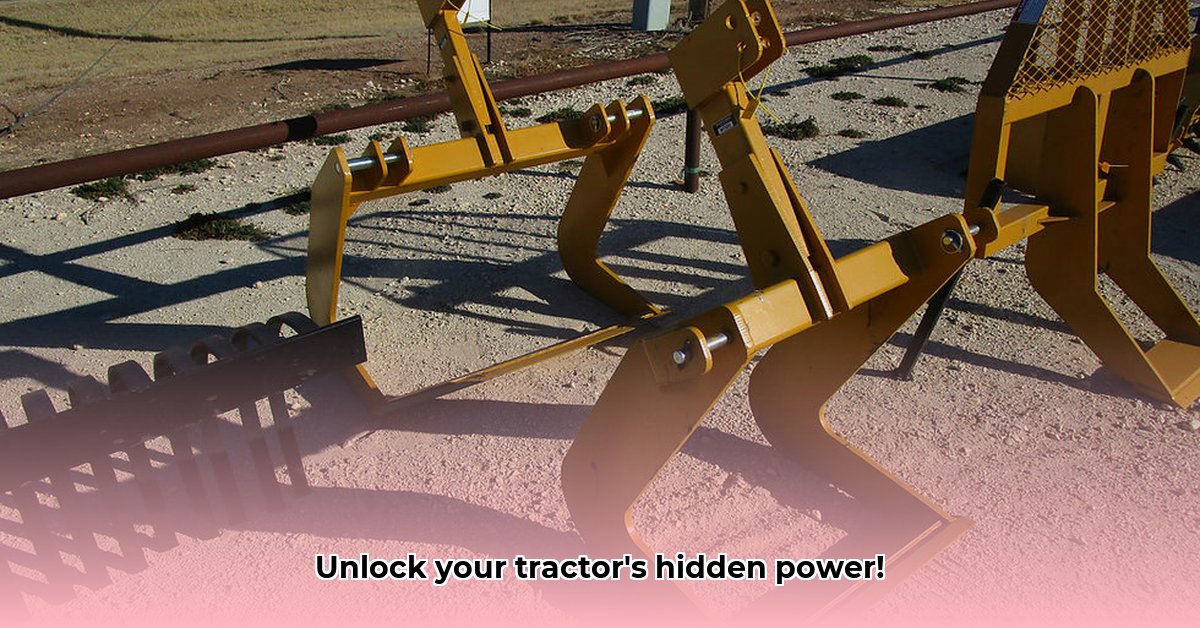
Tired of battling stubborn roots and rocks in your fields? A three-point hitch root rake can significantly improve your land clearing efficiency. This comprehensive guide provides a step-by-step approach to using a root rake effectively, covering assembly, operation, maintenance, troubleshooting, and safety. Whether you're a seasoned farmer or a new land owner, this guide will help you become a root-raking expert! For more information on tractor attachments, check out this helpful resource: Tractor Attachments.
Attaching Your Root Rake: Ensuring a Secure Connection
Properly attaching the root rake to your tractor's 3-point hitch is crucial for safe and efficient operation. Follow these steps meticulously:
Align the Arms: Carefully align the root rake's lift arms with your tractor's hitch arms. Precise alignment is essential for preventing damage and ensuring smooth operation.
Secure the Top Link: Connect the top link, ensuring it's firmly fastened. A loose top link can compromise stability and safety. Double-check for any looseness.
Connect the Lower Links: Attach the lower links, verifying each connection is tight and secure. Any play here could impact the rake's performance and lead to instability.
Final Inspection: Before proceeding, conduct a thorough inspection of all connections. This preventative measure minimizes risks of accidents and equipment damage. Is everything firmly attached?
Operating Your Root Rake: Techniques for Different Conditions
Operating a root rake requires a steady hand and an understanding of the nuances of varying soil types.
Initial Positioning: Raise the rake to its highest position before starting. This prevents accidental ground contact and aids in maneuverability.
Controlled Movement: Begin with slow, deliberate movements across the area. Excessive speed, especially on uneven terrain, can cause damage to both the rake and your tractor.
Depth Adjustment: Gradually lower the rake to the desired depth, using the tractor's lift arms for precise control. This will depend greatly on soil type and root density.
Adaptability: Be prepared to adjust the rake's depth as needed. This might involve raising it to clear obstacles or lowering it for more aggressive root removal.
Mindful Maneuvering: Maintain awareness of your surroundings, avoiding obstacles that could cause damage or accidents. Smooth, controlled movements are essential.
Mastering Different Soil Types: Adapting Your Approach
Soil type significantly impacts your root-raking technique. Here's a guide to optimizing your approach:
| Soil Type | Speed Recommendation | Depth Recommendation | Considerations |
|---|---|---|---|
| Sandy | Moderate to Fast | Moderate | Easier to work with; lower risk of damage. |
| Clay | Slow | Shallow | Higher resistance; avoid deep penetration for safety. |
| Rocky | Very Slow | Very Shallow | High risk of damage to tines; extreme caution needed. |
| Loamy | Moderate | Moderate to shallow | Adjust depth according to root density. |
Remember, these are guidelines; adjust techniques based on observations and experience.
Maintaining Your Root Rake: Prolonging its Lifespan
Regular maintenance ensures your root rake's longevity and optimal performance.
Post-Use Inspection: After each use, inspect tines for wear and tear. Replace or repair damaged components promptly.
Lubrication: Regularly lubricate moving parts to reduce friction and wear. Refer to your owner's manual for recommended lubricants and procedures.
Storage: Store the rake in a dry place, sheltered from the elements, to prevent rust and corrosion.
Prompt Repair: Address minor problems immediately to avoid them escalating into major issues. Prevention is key to extending your equipment's life.
Troubleshooting Common Problems: Quick Fixes
Even with proper care, issues can arise. Here are solutions to common problems:
Bent Tines: Carefully straighten or replace bent tines. Replacement tines are readily available at most farm supply stores.
Stuck Rake: Clear obstructions like rocks or debris cautiously before attempting to move the rake.
Uneven Operation: Check all connections; loose connections are a frequent cause of uneven operation.
Safety First: Prioritizing Safe Operation
Safety is paramount when operating farm equipment. Always:
Consult Manuals: Review your tractor and root rake manuals before operation.
Protective Gear: Wear appropriate safety gear, including eye protection.
Situational Awareness: Maintain awareness of your surroundings at all times.
Avoid Distractions: Never operate while fatigued or distracted.
Clear Work Area: Ensure the work area is free of obstacles before starting.
By following this guide, you'll master your tractor's 3-point hitch root rake, efficiently clearing land while prioritizing safety. Remember that experience refines technique. Get out there and start raking!